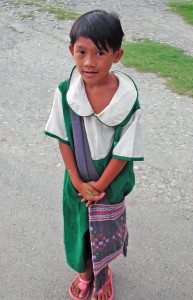Education in Burma
by Elizabeth Hoover / July 22, 2010 / 1 Comment
In 1820, Thomas Jefferson wrote to diplomat and financier William Jarvis, “I know no safe depository of the ultimate powers of the society but the people themselves; and if we think them not enlightened enough to exercise their control with a wholesome discretion, the remedy is not to take it from them, but to inform their discretion by education. This is the true corrective of abuses of constitutional power.”
Jefferson believed the foundation to democracy was a free and comprehensive educational system; one that not only informed the population but trained them in the kind of free and critical thinking that prepares them to keep a close watch on government. Whether the American educational system has achieved that some 200 years after Jefferson’s letter is subject to debate. However, these are the founding principles of American pedagogy.
While researching my article on the Burmese refugee community in Pittsburgh, I heard time and again that the refugees struggle with adapting to the American education system. They are used to a pedagogy based almost entirely on rote memorization. This is to ensure that the students won’t develop the kind of critical thinking skills that would enable to them to criticize the government or organize opposition. The government also strictly controls what information is available to students, leading to a skewed perspective on history and politics.
I spoke to an American who taught English in Burma who was shocked by gaps in history textbooks. (She asked that her name be withheld because she plans to return to Burma and Burmese officials search visa applicants’ names on the Internet.) She said she encountered students who were memorizing facts about World War II without knowing there was a World War I.
Burma’s 1973 Basic Education Law states the purpose of education as “train technicians, skilled workers and proficient intellectuals with practical knowledge who are loyal to the State and will contribute to nation-building endeavours.” Loyalty to the state doesn’t require an understanding of the cause-and-effect relationship between World War I and II.
Burmese refugee children in Pittsburgh. Photo by Renee Rosensteel
Since the military junta’s declaration of martial law in 1988, Burma’s educational system has deteriorated rapidly. Most of the universities and college were closed in that year because of student protests, so opportunities for higher education are severely limited.
Primary education is underfunded or overlooked. The Burmese government spends less that 2 percent of the GDP on education. Education is compulsory only to the fifth grade, and Canadian Friends of Burma estimate that 2/3 to 3/4 of children drop out of school before then. In contrast, American dropout rates hover around 4 percent—the majority of which occur in high school.
Monasteries and NGOs are trying to step in and fill the gap. One monastery runs a school with 7,000 students and provides not only an education, but also food and basic medical care. The monk interviewed for this post about the school asked that neither his name nor the school’s name and location be published. During the interview he expressed concern that democracy isn’t a possibility without good education, an education that is based on more that root memorization. However, he said his teachers lack the skills to go beyond teaching this type of teaching because they themselves lack education.
Keeping a population in a state of ignorance is one of the many tools of a dictatorship. Without knowledge of alternative political systems, you may think that a dictatorship is a democracy, as one refugee reported. With that, a dictatorship can imprison a population in the dark, voiceless.
You can read more about Burmese refugees transitioning to life in Pittsburgh in our upcoming special issue on Burma. Click here to subscribe and receive a notice when the magazine is published.
Read Elizabeth’s bio.







One Comment on "Education in Burma"
Well done and thankyou.